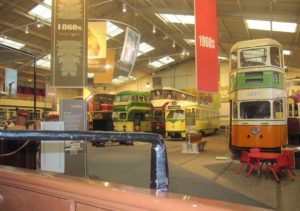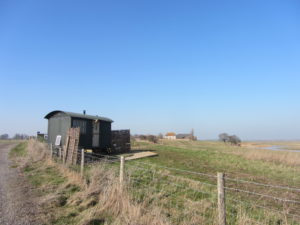Blackpool was the first seaside resort to possess an electric tramway in Britain when Michael Holroyd Smith opened his conduit tramway along the promenade, in 1885. At the end of the Second World War there were thirty towns and cities possessing electric tramway systems as well as a few ‘interurban’ tramways who preferred to call themselves electric railways such as the ‘Grimsby and Imingham’, the ‘Llandudno & Colwyn Bay’ and the ‘Manx Electric’.
As well as an authority on steam trains and creator of his own minature garden railway, my father also had a keen interest in trams and often visited Blackpool and Fleetwood. He found great joy and satisfaction building small models of trams in his garage workshop, spending a great time on detail.
So, when visiting the Peak District in October, I had the opportunity of visiting Crich Tramway Village, home of the National Tramway Museum near Matlock and learning more of the history of these wonderful modes of transport .
Even if you don’t have a keen interest in trams, transport and history, it’s simply a great day out which you are certain to enjoy. The village is run by a team of dedicated staff and volunteer enthusiasts, who, as I discovered, are only too pleased to talk about the village, what they do and answer any questions you may have.
There’s so much to see and do, and as you stroll down the cobbled main street, it’s like taking a step back in time. Each side of the street is flanked by period buildings and street furniture from all over the country such as a Victorian cast-iron urinal from Reading, gas street lighting from Oldham and elegant gates from the dismantled Birmingham Wholesale Market Hall.
At Town End, stands a grand Georgian frontage of the Derby Assembly Rooms originally built between 1765 and 1774. Following a fire in 1963, what survived, was moved to Crich in 1972 where it was later re-opened in 1976 by the Duke of Gloucester. Today, it houses a video theatre with displays, telling the story of British tramways.
Nearby, is the Yorkshire Penny Bank and the Burnley Tramway Company offices which now house the John Price Memorial Library and archives of The National Tramway Museum.
Barnett’s Sweetshop displays rows of jars of sweets, just like the old days when you could buy a ‘quarter’ of whatever took your fancy. Lollipops, chocolate umbrellas, old fashioned chocolate bars are to name but a few items on offer in this charming, colourful and quaint shop. Children’s eyes light up when they enter this Aladdin’s cave of treats!
The Red Lion Pub, rescued from Stoke-on-Trent was rebuilt brick by brick and now houses the Poulson Room Restaurant and Lower Deck Major’s Bar. We never went inside, but instead chose to visit Rita’s Tea Room for a cup of coffee before catching the open topped tram for a ride.
It was a lovely crisp, sunny day with a cloudless sky, so had a good view after climbing the narrow winding stairway to the top deck of the tram. The trams transport visitors along the cobbled streets, past the historic buildings, the Bowes-Lyon bridge cast in 1844, the Victorian bandstand, the Woodland Walk and Sculpture Trail, and out into the scenic views of the Derwent Valley, passing the Cliff Quarry. The ‘clippie’ comes along and collects your fare (genuine old pennies from before decimalization), given to you when you pay your entrance fee. You can sit back and soak in the atmosphere on a memorable experience. When you reach the stage for the return journey, the wooden seats are made to flip back in reverse so passengers always face the direction of travel.
The Exhibition Halls are very interesting to walk around. You can take a fascinating journey through a hundred years of tramway development from 1860 – 1960, taking in steams trams, horse trams and electric trams. The George Stephenson Discovery Centre has a two storey Stephenson Workshop built in the 1800’s, standing in the centre of the Museum. It was restored with money from the Lottery Fund and opened in 2011. Now, it is a new state of the art learning facility on the ground floor with the Discovery Centre located on the first floor.
Many vintage trams are put ‘back on track’ and then enter the operational fleet. They are able to carry passengers just as they did in their original home towns and are kept in good condition with regular service and maintenance.
50 trams are on display at the Village with some in storage awaiting restoration and some on loan to other museums around the world.
Some of the fleet include the Blackpool Boat Car 236 – a more recent addition arriving in 2012. Built in the 30’s by English Electric, it is a modern version of the traditional toast rack, mainly used during the summer season.
The ‘Leeds 345’ entered service as a balcony car in 1921 and became completely enclosed in 1939. It was withdrawn in 1948 and arrived at Crich in 1959 where it was restored to it’s 1939 condition. In April 2006 it re-entered service.
London United Tramways 159 certainly has a history to tell since it last ran in the 1920’s. Built in 1902 it was sold in 1923 and converted into a house and relocated to Ewhurst Green in Surrey where it remained as a home to a couple for 55 years. It was then donated to the Museum and stored off site until 2005. It was then considered to fill a gap in the collection to demonstrate the period of the late 1902.
‘Glasgow 1068’ – Car 68 was built in 1919 for the Paisley District Tramways as an open top tramcar. In 1923 when Glasgow took over the Paisley system, the car was painted in Glasgow ‘blue’ route colour and numbered 1068. It was later top covered and enclosed and put to one side for preservation in 1953.
So many stories …
The works of the tramcar are fascinating. Either single, or double decked, most British trams can be driven from either end and do not have to be turned round at the terminus. The system is like a large electric circuit with the electricity traveling from a generating station through overhead wires, where it is collected by the tramcar through a current collector. Electricity is then returned from the tramcar along the tramway rails. Overhead voltage is about 550 volts. Overhead wires have been retrieved from all over the country.
2015 at Crich has put a spotlight on how tramways continued to operate through the First World War in their new, temporary exhibition. Recruitment of men for the army left many tramways short of staff. Women took on extra roles in an industry in order to keep the country’s trams on track and moving.
We never had time to do the Woodland Trails, but am sure children enjoy some fun time there.
So much to see and do for both young and old!
Entry 2015 is Adults £14. Senior £11 Children (4-15) £8 Family (2 adults and 3 children0 £37.
Opening times 28th March – 1st November 10am – 5.30pm.
The Forge Gift shop is the place to head for your gift/souvenirs.










